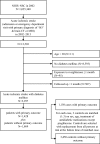Effect of pioglitazone in acute ischemic stroke patients with diabetes mellitus: a nested case-control study
- PMID: 31151454
- PMCID: PMC6545002
- DOI: 10.1186/s12933-019-0874-5
Effect of pioglitazone in acute ischemic stroke patients with diabetes mellitus: a nested case-control study
Abstract
Background: Pioglitazone is an oral antidiabetic drug with multiple pleiotropic actions. Recent clinical trials have demonstrated that treatment with pioglitazone reduces cardiovascular risk in patients who have had an ischemic stroke. We examined the secondary preventive effects of pioglitazone in acute ischemic stroke patients with diabetes mellitus (DM) based on nationwide real-world data.
Methods: A nested case-control study was conducted with data from the National Health Insurance Service-National Sample Cohort in Korea. Study subjects were diabetic patients admitted for acute ischemic stroke (ICD-10 code; I63) between 2002 and 2013. Cases were defined as patients who suffered from composites of recurrent stroke (I60-63), myocardial infarction (I21), or all-cause mortality after ischemic stroke. Controls were selected by incidence density sampling. Three controls were matched to each case for sex, age, treatment with insulin, and oral antidiabetic medications, with the exception of pioglitazone. Medication history after ischemic stroke was obtained by accessing the prescription records. In the matched dataset, conditional logistic regression analysis was performed with adjustments for hypertension, atrial fibrillation, prior myocardial infarction, and treatment with oral antithrombotics and statins.
Results: From the patients with acute ischemic stroke and DM, 1150 cases with primary outcomes were matched to 3450 controls. In the matched analysis, treatment with pioglitazone was significantly associated with a lower cardiovascular risk (adjusted OR [95% CI], 0.43 [0.23-0.83]).
Conclusions: In this nested case-control study using real-world data, treatment with pioglitazone exhibited significant cardiovascular preventive effect in diabetic patients with acute ischemic stroke.
Keywords: Diabetes mellitus; Ischemic stroke; Pioglitazone; Secondary prevention.
Conflict of interest statement
The authors declare that they have no competing interests.
Figures



Similar articles
-
Pioglitazone use associated with reduced risk of the first attack of ischemic stroke in patients with newly onset type 2 diabetes: a nationwide nested case-control study.Cardiovasc Diabetol. 2021 Jul 27;20(1):152. doi: 10.1186/s12933-021-01339-x. Cardiovasc Diabetol. 2021. PMID: 34315501 Free PMC article.
-
Pioglitazone and PPAR-γ modulating treatment in hypertensive and type 2 diabetic patients after ischemic stroke: a national cohort study.Cardiovasc Diabetol. 2020 Jan 7;19(1):2. doi: 10.1186/s12933-019-0979-x. Cardiovasc Diabetol. 2020. PMID: 31910836 Free PMC article.
-
Lobeglitazone, a novel thiazolidinedione, for secondary prevention in patients with ischemic stroke: a nationwide nested case-control study.Cardiovasc Diabetol. 2023 May 5;22(1):106. doi: 10.1186/s12933-023-01841-4. Cardiovasc Diabetol. 2023. PMID: 37147722 Free PMC article.
-
Rethinking pioglitazone as a cardioprotective agent: a new perspective on an overlooked drug.Cardiovasc Diabetol. 2021 May 18;20(1):109. doi: 10.1186/s12933-021-01294-7. Cardiovasc Diabetol. 2021. PMID: 34006325 Free PMC article. Review.
-
Pioglitazone for Secondary Stroke Prevention: A Systematic Review and Meta-Analysis.Stroke. 2017 Feb;48(2):388-393. doi: 10.1161/STROKEAHA.116.013977. Epub 2016 Dec 20. Stroke. 2017. PMID: 27999139 Review.
Cited by
-
Pleiotropic Effects of Peroxisome Proliferator-Activated Receptor Alpha and Gamma Agonists on Myocardial Damage: Molecular Mechanisms and Clinical Evidence-A Narrative Review.Cells. 2024 Sep 5;13(17):1488. doi: 10.3390/cells13171488. Cells. 2024. PMID: 39273057 Free PMC article. Review.
-
Effectiveness of famotidine on the risk of poor prognosis in patients with COVID-19: A nationwide cohort study in Korea.Heliyon. 2023 Jun;9(6):e16171. doi: 10.1016/j.heliyon.2023.e16171. Epub 2023 Jun 1. Heliyon. 2023. PMID: 37287614 Free PMC article.
-
Effect of saroglitazar 2 mg and 4 mg on glycemic control, lipid profile and cardiovascular disease risk in patients with type 2 diabetes mellitus: a 56-week, randomized, double blind, phase 3 study (PRESS XII study).Cardiovasc Diabetol. 2020 Jun 19;19(1):93. doi: 10.1186/s12933-020-01073-w. Cardiovasc Diabetol. 2020. PMID: 32560724 Free PMC article. Clinical Trial.
-
Pioglitazone use associated with reduced risk of the first attack of ischemic stroke in patients with newly onset type 2 diabetes: a nationwide nested case-control study.Cardiovasc Diabetol. 2021 Jul 27;20(1):152. doi: 10.1186/s12933-021-01339-x. Cardiovasc Diabetol. 2021. PMID: 34315501 Free PMC article.
-
Impaired glucose metabolism and the risk of vascular events and mortality after ischemic stroke: A systematic review and meta-analysis.Cardiovasc Diabetol. 2024 Aug 31;23(1):323. doi: 10.1186/s12933-024-02413-w. Cardiovasc Diabetol. 2024. PMID: 39217364 Free PMC article.
References
-
- Megherbi S-E, Milan C, Minier D, Couvreur G, Osseby G-V, Tilling K, et al. Association between diabetes and stroke subtype on survival and functional outcome 3 months after stroke: data from the European BIOMED Stroke Project. Stroke. 2003;34:688–694. doi: 10.1161/01.STR.0000057975.15221.40. - DOI - PubMed
Publication types
MeSH terms
Substances
LinkOut - more resources
Full Text Sources
Medical

